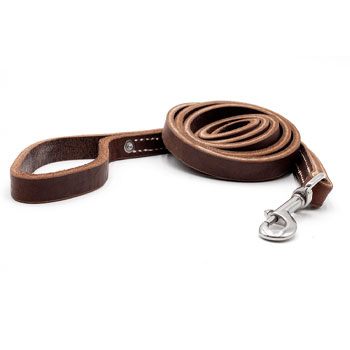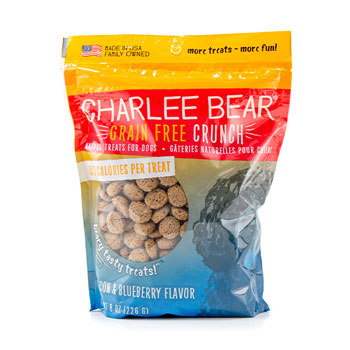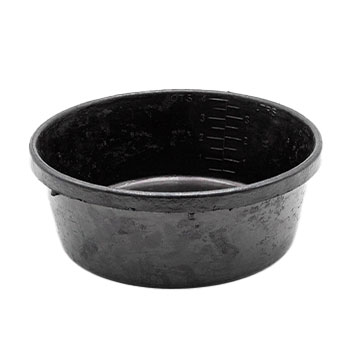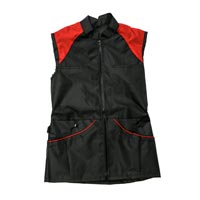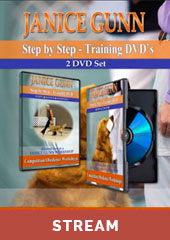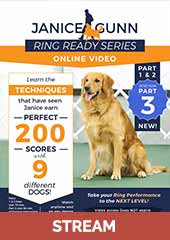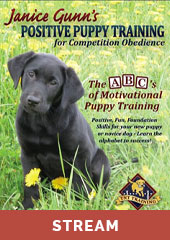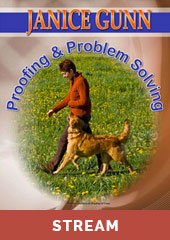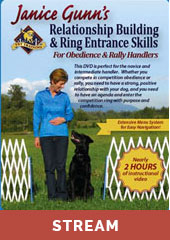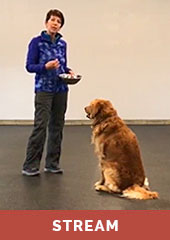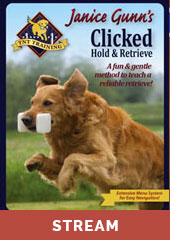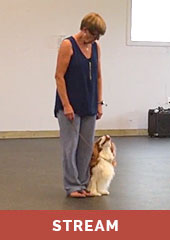
Push Heeling with Janice Gunn
Push Heeling
This method is taught to Sparks as a puppy. It is similar to what many European and IPO handlers teach, although Janice has made some changes to suit her sport of choice which is AKC/CKC competition obedience. Janice wanted to try this method as it allowed her to have more hand on contact when teaching. It is also a way to teach more collection and active heeling if you follow through using all the tools provided in this video series. It can be more difficult for a novice trainer to teach, but if your dog does not connect with the armband method this is a great alternative. This is not a recommended method of heeling for small dogs.
Pot Work & Teaching Get the Rear in Foundation Exercises
Janice felt it was important to include some basic foundation skills that will help you to achieve your heeling goals. In these exercises she emphasizes rear end awareness and how to help your dog keep his rear in. One of the common problems in heeling is that the dog tends to "crab" which is heeling with the rear end out, this equals points off in the ring. Left turns are also difficult for many handlers and results in the handler turning left and the dog bumps into you by not picking up on your cue. This foundation work will help a lot of these issues, and it is also a fun exercise for your dog to learn.
Heeling Helpers
Teaching Hand on Outside of the Dog's Head
You will see dogs that are trained in IPO competing and their handler's hand is on the outside of the head when they are heeling. Janice wishes we could do the same in our sport, but we can't and the challenge is when we put out hand at out waist, the dog tends to want to come forward. The skill of teaching your dog to have your hand on the outside of their head is very valuable throughout their career to help maintain proper heel position. In this section Janice will show you how to teach this and where you can place your reinforcement to provide your dog with a focal point for times when your hand is on the outside OR at your waist.
Comments
It depends on who you are in your competitive obedience work. If you're a person like me, who has been training for a while, using a variety of techniques, all the preliminary work, and language of operant conditioning is already part of our vocabulary. If you're a total beginner, this video is not where you would necessarily start.
I think Janice did an outstanding job teaching perch work, stationary positions and movement. I think she combined very nicely all the foundation work in stationary positions and she also shows how to use various tools that aid in the head-up position: something never shown in other videos. While these helper tools don't teach the behavior, it helps to better shape the behavior. The pretty prance and driving from the rear is shown. This is a different kind of finished product that you lately see in the IPO world, of head straight up, since attention heeling and watching the owner's face is not really shown. How to reward in the right position, not to cause the dog to wrap around you and forge is shown also. Again, very good technique and a bit different than you normally see in the IPO sport dog world, but still perfectly valid. I think if the introduction shows a reference to the other Leerburg videos of operant conditioning and developing drive and the food DVD from Michael Ellis and the Tug DVD, it would be better integrated into the Leerburg series overall. But this is a TERRIFIC different teaching method . The only slight criticism is to give the person watching some idea of frequency of events. Like for example, practice head-up position for 15 reps for 3 weeks, 3 times per day,before going to step2. In other words, giving a feel for the time it takes per step, would be helpful.
Overall, a very informative and useful video! Props to Leerburg to adding this well known AKC trainer into their stable.

